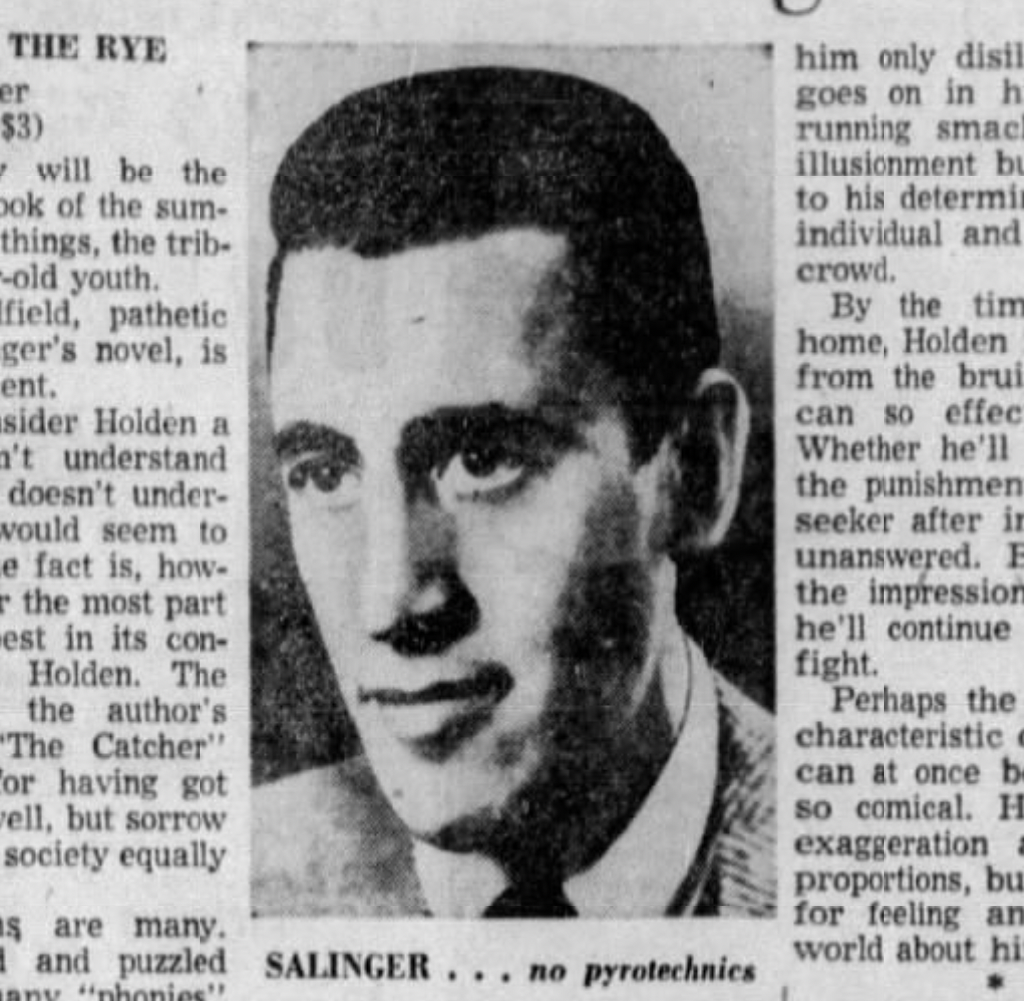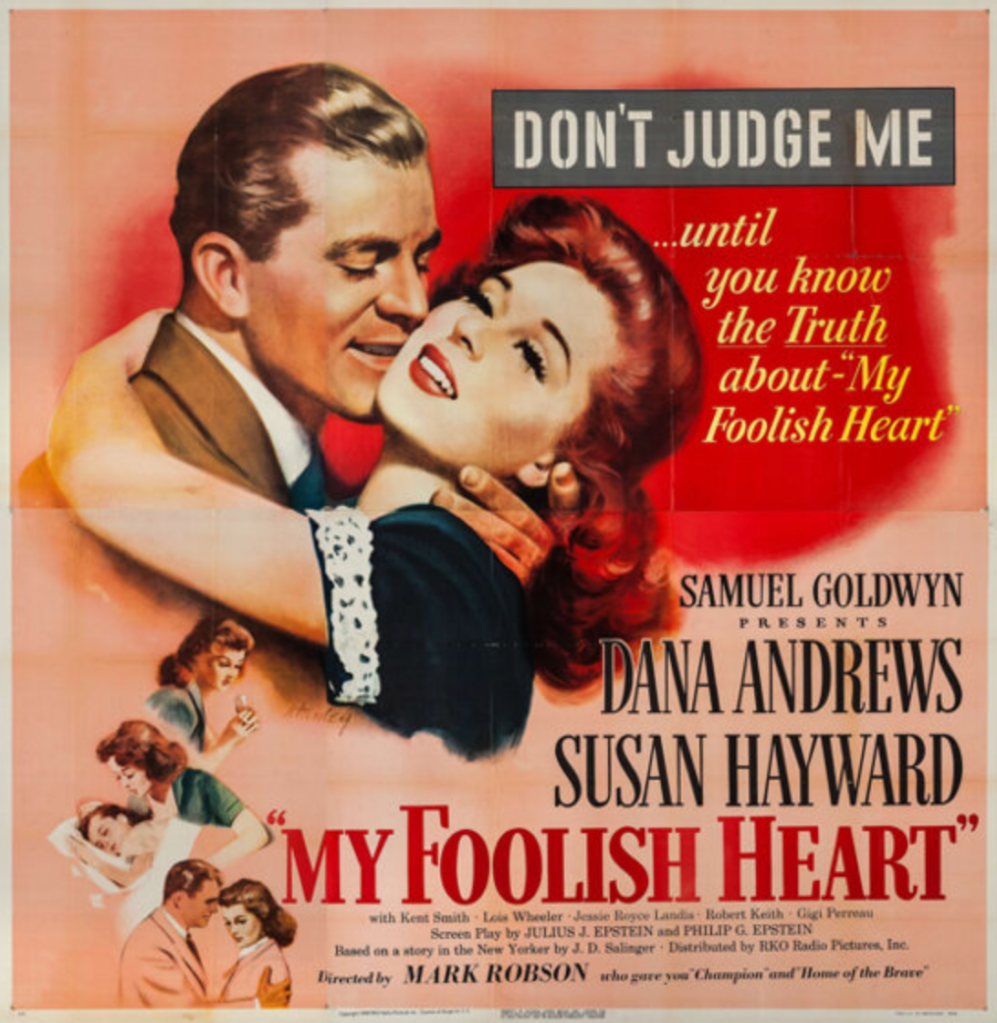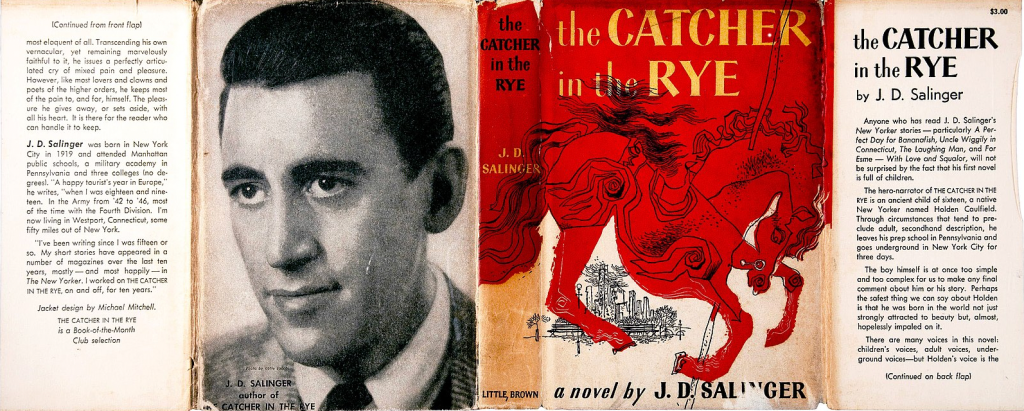Born: January 1, 1919
Died: January 27, 2010

There is what amounts to a cult growing up among ecstatic readers of short story writer J. D. Salinger, a master craftsman whose devotees are surprisingly numerous in view of the fact that he has published a mere handful of yarns. Daily News, Los Angeles, May 2, 1949
Catcher in the Rye was still two years away from being published when the story above was written. With a handful of stories in The New Yorker and a couple other publications, Salinger was just starting to make his mark and attract fervent fans. While he probably wouldn’t approve of me writing about his early years and rise to a level of fame so burdensome that he became a recluse, I just couldn’t resist. So, here we go …
Salinger’s first published story, The Young Folks, appeared in the Story magazine in 1940. He then had a couple of stories rejected by The New Yorker, until finally, in late 1941, the magazine accepted Slight Rebellion Off Madison, which featured Holden Caufield. However, the Japanese bombed Pearl Harbor on December 7, 1941, and the story was shelved and didn’t run in the magazine until five years later.
World War II molded a generation of several soon-to-be important writers, including Salinger, who served as a counter-intelligence officer. He landed on the beaches of Normandy on D-Day, fought in the Battle of the Bulge, and saw first-hand the horrors of the concentration camps. He continued to write while he served in Europe and The Saturday Evening Post published The Varioni Brothers in its July 17, 1943 issue. In an ad for the issue that ran in newspapers, the copy described the short story as …
… the fabulous story of two brothers who wrote song hits the whole nation sang. In the midst of a drinking orgy one was shot – the other disappeared. And now a girl who knew them in obscurity and fame solves the tragic mystery in the lives of the two who were great.

While overseas, Salinger met and married Sylvia Welter, a German woman, and they returned to the States together. The marriage was over in about eight months and Welter returned to Germany. Salinger continued to write short stories and had some success …
He was young, tired and half sick. But for a few minutes he forgot the misery of foxhole life while he re-read a crumpled letter from home. J. D. Salinger’s “A Boy In France,” will be dramatized on the “Listening Post” program over WSLS and the BLUE Network on Tuesday, April 3, at 10:45 a.m. The Roanoke Times, Virginia, April 1, 1945
Slight Rebellion Off Madison was finally published by The New Yorker in its December 21, 1946, issue. The editors encouraged Salinger to submit more stories, which he was happy to do. The New Yorker was “the” place for the best short stories of the day. A Perfect Day for Bananafish was published on January 31, 1948, and was the first story to feature the Glass family. Uncle Wiggily in Connecticut was published in the March 20, 1948, issue.
Dana Andrews and Teresa Wright have been named by Samuel Goldwyn to co-star in a movie which will be made from a short story by J.D. Salinger which appeared the New Yorker magazine recently under the title of “Uncle Wiggily in Connecticut.” Goldwyn … will right the script. Pittsburgh Post-Gazette, August 16, 1948
In the May 2, 1949, article in the Daily News of Los Angeles that described how a cult was growing around Salinger, the reporter, Darr Smith, wrote …
… at first glance it would appear that the hitherto unerring commercial Goldwyn eye had astigmatism at the time of purchase. While it’s a great story, it hardly seems suitable for a film. It has to do with two brittle, super-sophisticated, hateful women who spend an afternoon getting terribly drunk. One despises her husband and is brutal to her young daughter. Their dialogue is almost incredibly bitter.
The plot was changed dramatically, so much so that the movie (called My Foolish Heart) barely resembled Salinger’s original story. Susan Hayward replaced Wright and, despite so-so and negative reviews for the film, she was nominated for an Oscar. Salinger was so disgusted by the movie that he never again sold the rights to any of his stories or books.

Salignger continued to write short stories for The New Yorker. To Esme: With Love and Squalor was selected for Prize Stories of 1950: The O. Henry Awards, a collection of the year’s best short stories.
Salinger is a great one. Able to combine the horrible with the comic and still make you feel good about it. He’s one of the (you should pardon the expression) “New Yorker” school (?). Take his thing in “Prize Stories.” It’s called “To Esme: With Love and Squalor.” The title itself has something to offer, but the story is what the more enthusiastic English III boys would call a “gem.” Has to do with an American soldier who meets as English lass … chuckles over her, then goes away to fight a war. Comes then, combat fatigue. Depression. Worries. Images of padded cells. The Charlotte News, North Carolina, October 28, 1950

Catcher in the Rye was published in 1951 and was an immediate literary sensation.
Once in a blue moon there appears on the American literary scene a young voice so articulate, so understanding, so full of humor, love and pity, that jaded book reviewers must stop dead in their tracks and rejoice. The Gazette, Cedar Rapids, Iowa, July 15, 1951
What very likely will be the most talked-about book of the summer concerns, of all things, the tribulations of a 16-year-old youth. But Holden Caufield, pathetic hero of J.D. Salinger’s novel, is no ordinary adolescent. Dayton Daily News, Ohio, July 15, 1951
A story in the October 21, 1951, issue of The Orlando Sentinel provided a few clues into the life of Salinger …
He now lives in Westport, Conn., with a dog, and writes short stories for The New Yorker. The Catcher in the Rye, his first novel, was originally a novelette 90 pages long, and although the publisher was willing to issue it in that form, Salinger preferred to write it over its present length. He has refused to let Hollywood acquire the book, lest they destroy its special quality.
Salinger never did sell the rights to Catcher. And soon after its publication he began to retreat from public life.
No author ever isolated himself as successfully as has J.D. Salinger … Salinger prefers to remain with his wife and their two daughters, at their home in Cornish, N.H. The children call him “Funny Face” and he tries to be funny with them when he drives them to school every day. The neighbors are so curious about the family that when Mrs. Salinger went shopping for groceries in nearby Windsor the local paper got a copy of her order and headlined: “What J.D. Salinger Has for Breakfast.” … a letter arrived from M-G-M offering $250,000 for the movie rights to his “Catcher in the Rye.” Mrs. Salinger, who knew he’d never consider the offer, didn’t even show him the letter. The Post-Standard, Syracuse, New York, June 18, 1962
If you found this story interesting, you might like to read my From Unknown to Famous stories about Bruce Springsteen, Ernest Hemingway, Marilyn Monroe, Amelia Earhart, Babe Ruth, Jackie Robinson, Elvis and Alex Trebek. Please subscribe to this blog and get alerts every time I post a new one (lots more are coming).

